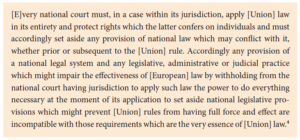1. National Remedies: Equivalence and Effectiveness
2. State Liability: The Francovich Doctrine
3. Preliminary Rulings I: General Aspects
4. Preliminary Rulings II: Special Aspects
Introduction*
National courts are the principal judicial enforcers of European law. ‘Ever since Van Gend en Loos the Court has maintained that it is the task of the national courts to protect the rights of individuals under [Union] law and to give full effect to [Union] law provisions.’ Indeed, whenever European law is directly effective, national courts must apply it; and wherever a Union norm comes into conflict with national law, each national court must disapply the latter. The Union legal order thereby insists that nothing within the national judicial system must prevent national courts from exercising their functions as ‘guardians’ of the European judicial order. In Simmenthal, the Court thus held that each national court must be able to disapply national law—even where the national judicial system traditionally reserved that power to a central constitutional court:
Functionally, the direct effect (and supremacy) of European law thus transforms every single national court into a ‘European’ court. This decentralized system differs from the judicial system in the United States in which the application of federal law is principally left to ‘federal’ courts. Federal courts here apply federal law, while State courts apply State law. The European system, by contrast, is based on a philosophy of cooperative federalism: all national courts are entitled and obliged to apply European law to disputes before them. In opting for the decentralized judicial enforcement via State courts, the EU judicial system thereby comes close to German judicial federalism; yet, unlike the latter, State courts are not hierarchically subordinated. Indeed, there is no compulsory appeal procedure from the national to the European Courts; and the relationship between national courts and the European Court is thus based on their voluntary cooperation. National courts are consequently only functionally—but not institutionally—Union courts. The three distinct models of judicial federalism can be seen in Figure 7.1.

Figure 7.1 Judicial federalism in comparative perspective (included with permission of Oxford University Press)
Has the Union therefore had to take State courts as it finds them? The Union has indeed traditionally recognized the ‘procedural autonomy’ of the judicial authorities of the Member States:
This formulation has become known as the principle of ‘national procedural autonomy’. It essentially means that in the judicial enforcement of European law, the Union ‘piggybacks’ on the national judicial systems. Yet the danger of such ‘piggybacking’ is that there may be situations in which there is a European right but no national remedy to enforce that right. But rights without remedies are ‘pie in the sky’: a metaphysical meal. Each right should have its remedy; and for that reason, the autonomy of national enforcement procedures was never absolute. The Union has indeed imposed a number of obligations on national courts. The core duty governing the decentralized enforcement of European law by national courts is thereby rooted in Article 4(3) TEU: the duty of ‘sincere cooperation’. It is today complemented by Article 19(1), which states: ‘Member States shall provide remedies sufficient to ensure effective legal protection in the fields covered by Union law’.
What does this mean; and to what extent does it limit the procedural autonomy of the Member States? This chapter explores this very question. We shall start with two specific constitutional principles that the Court has derived from the general duty of sincere cooperation: the principle of equivalence and the principle of effectiveness. Both principles have led to a significant judicial harmonization of national procedural laws, and this chapter analyses their evolution in Section 1. Section 2 then turns to a second—and much more intrusive—incursion into the procedural autonomy of the Member States: the State liability principle. If the principles of equivalence and effectiveness ultimately rely on the existence of national remedies for the enforcement of European law, this principle establishes a European remedy. An individual could here, under certain conditions, claim compensatory damages resulting from a breach of European law.
Finally, we shall explore the procedural bridge that exists between national courts and the European Court of Justice. For in the absence of an ‘institutional’ connection between the European Court and the national courts, how has the Union legal order guaranteed a degree of uniformity in the decentralized judicial enforcement of European law? From the very beginning, the Treaties contained a mechanism for the interpretative assistance of national courts: the preliminary reference procedure. The general and specific aspects of that procedure will be discussed in Sections 3 and 4. Suffice it to say here that the European Court is only indirectly involved in the judgment delivered by the national court. It cannot ‘decide’ the case, as the principal action continues to be a ‘national action’.
*All footnotes have been omitted for this excerpt.


